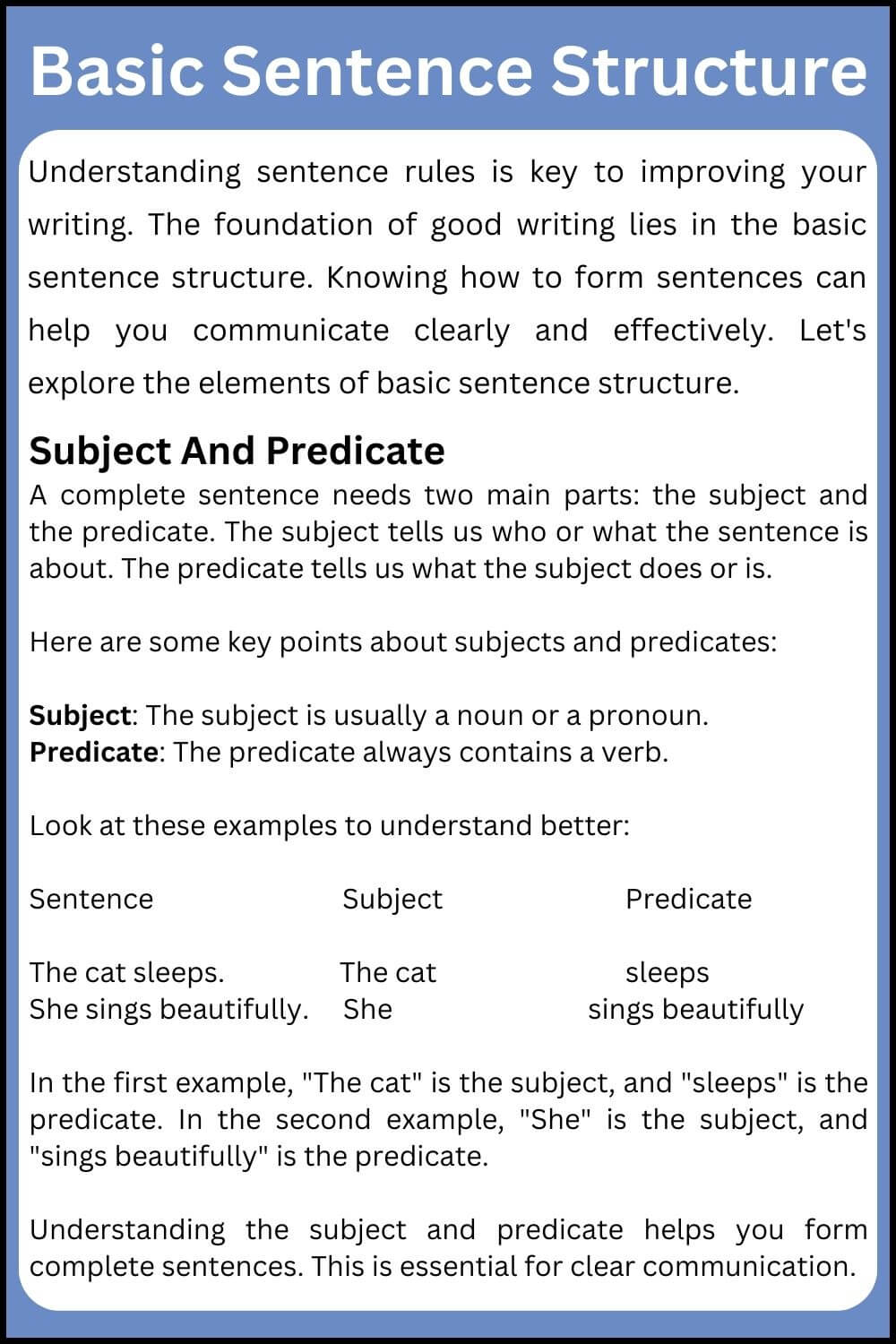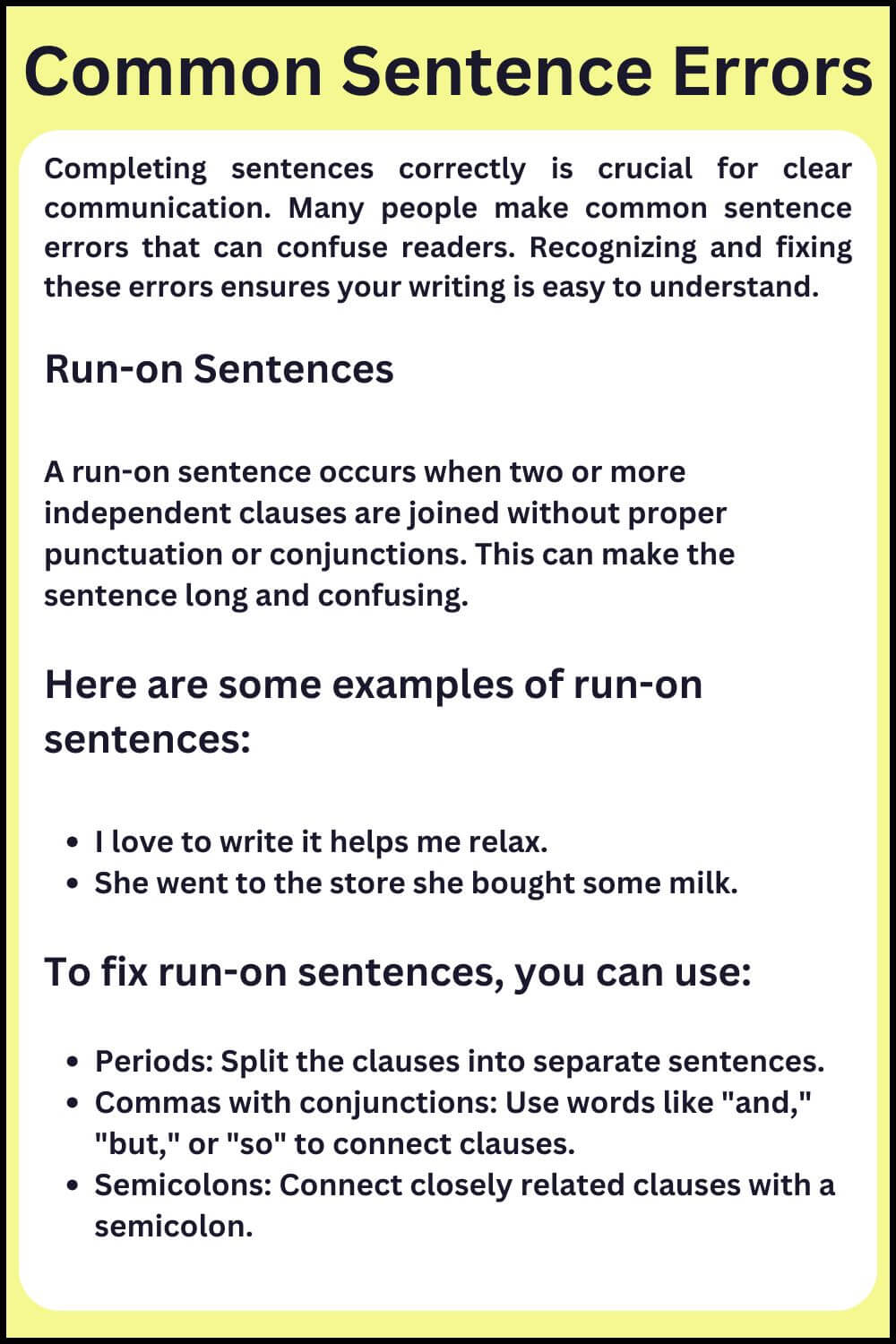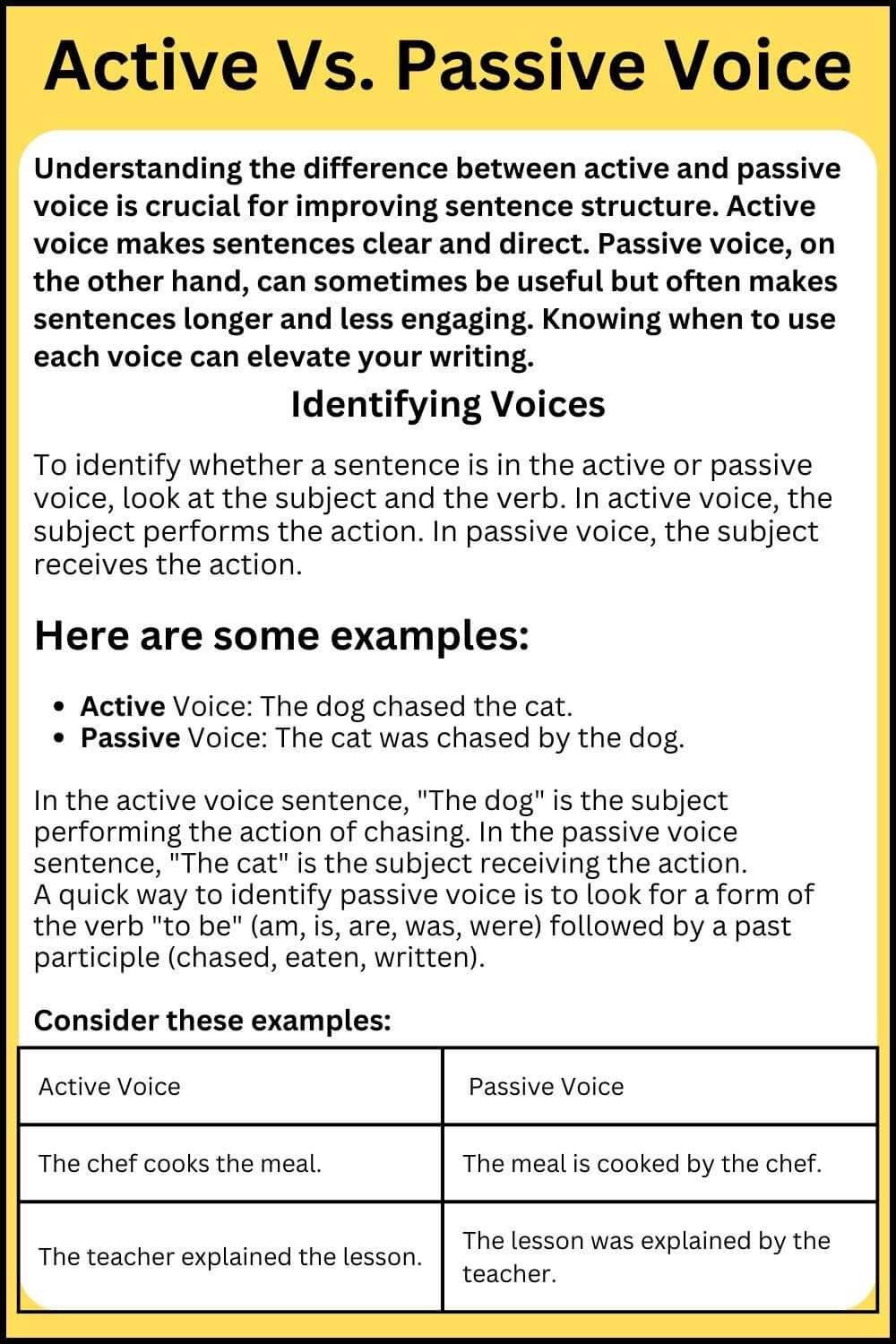Completing sentences correctly is crucial for clear communication. Good sentence structure ensures your message is understood.
Understanding the rules for completing sentences can improve your writing. Whether you’re a student, professional, or just someone who loves writing, knowing these rules helps. It makes your text clear and engaging. This blog post will explore essential rules for completing sentences.
You’ll find practical tips to enhance your writing skills. Let’s dive into the world of sentence structure and make your writing shine!
Basic Sentence Structure
Understanding sentence rules is key to improving your writing. The foundation of good writing lies in the basic sentence structure. Knowing how to form sentences can help you communicate clearly and effectively. Let’s explore the elements of basic sentence structure.
Subject And Predicate
A complete sentence needs two main parts: the subject and the predicate. The subject tells us who or what the sentence is about. The predicate tells us what the subject does or is.
Here are some key points about subjects and predicates:
- Subject: The subject is usually a noun or a pronoun.
- Predicate: The predicate always contains a verb.
Look at these examples to understand better:
| Sentence | Subject | Predicate |
| The cat sleeps. | The cat | sleeps |
| She sings beautifully. | She | sings beautifully |
In the first example, “The cat” is the subject, and “sleeps” is the predicate. In the second example, “She” is the subject, and “sings beautifully” is the predicate.
Understanding the subject and predicate helps you form complete sentences. This is essential for clear communication.

Sentence Types
Sentences come in different types. Each type serves a different purpose. Knowing these types can help you vary your writing style.
Here are the four main types of sentences:
- Declarative Sentences: These sentences make a statement. They end with a period.
- Example: The sky is blue.
- Interrogative Sentences: These sentences ask a question. They end with a question mark.
- Example: What time is it?
- Imperative Sentences: These sentences give a command or request. They end with a period or exclamation mark.
- Example: Please sit down.
- Exclamatory Sentences: These sentences express strong emotion. They end with an exclamation mark.
- Example: That’s amazing!
Each sentence type has a unique function. Declarative sentences share information. Interrogative sentences seek answers. Imperative sentences give instructions. Exclamatory sentences show strong feelings.
Using different sentence types makes your writing more interesting. It also helps you express your thoughts more effectively.
Punctuation Essentials
Learning the rules for completing sentences is essential for clear communication. Punctuation marks are small but mighty tools that help us convey meaning and emotion in writing. Understanding the essentials of punctuation can make your sentences more effective and engaging.
Commas And Periods
Commas and periods are the most common punctuation marks. They play a crucial role in sentence structure.
Commas help break up sentences into smaller parts. They signal pauses and separate items in a list. Here are some key uses:
- Separating items in a series: “I bought apples, oranges, and bananas.”
- Setting off introductory elements: “After the show, we went for dinner.”
- Separating independent clauses with a conjunction: “She wanted to go, but she felt tired.”
- Setting off non-essential information: “My brother, who lives in New York, is visiting.”
Periods indicate the end of a sentence. They show that a thought is complete. Use periods to:
- End declarative sentences: “The cat is sleeping.”
- End imperative sentences: “Close the door.”
- After abbreviations: “Dr. Smith is here.”
Proper use of commas and periods ensures your sentences are clear and easy to read.
Semicolons And Colons
Semicolons and colons are less common but still important. They help connect closely related ideas and introduce new information.
Semicolons link two independent clauses that are closely related. They show a stronger connection than a period but a weaker one than a conjunction. For example:
- “I have a big test tomorrow; I can’t go out tonight.”
- “She loves painting; it relaxes her.”
Semicolons can also separate items in a complex list:
- “On our trip, we visited Paris, France; Rome, Italy; and Berlin, Germany.”
Colons introduce a list, quote, explanation, or example. They direct attention to the information that follows. Here are some uses:
- Before a list: “You need to buy: bread, milk, and eggs.”
- Before a quote: “She said: ‘I will be there soon.'”
- Before an explanation: “He was late: his car broke down.”
Using semicolons and colons correctly can make your writing more sophisticated and clear.
Common Sentence Errors
Completing sentences correctly is crucial for clear communication. Many people make common sentence errors that can confuse readers. Recognizing and fixing these errors ensures your writing is easy to understand.
Run-on Sentences
A run-on sentence occurs when two or more independent clauses are joined without proper punctuation or conjunctions. This can make the sentence long and confusing.
Here are some examples of run-on sentences:
- I love to write it helps me relax.
- She went to the store she bought some milk.
To fix run-on sentences, you can use:
- Periods: Split the clauses into separate sentences.
- Commas with conjunctions: Use words like “and,” “but,” or “so” to connect clauses.
- Semicolons: Connect closely related clauses with a semicolon.
For example:
| Run-on Sentence | Fixed Sentence |
| I love to write it helps me relax. | I love to write. It helps me relax. |
| She went to the store she bought some milk. | She went to the store, and she bought some milk. |

Remember: Proper punctuation and conjunctions are key to avoiding run-on sentences.
Fragments
Fragments are incomplete sentences that lack a subject, verb, or complete thought. They can confuse readers by leaving them wondering what the rest of the sentence is.
Examples of sentence fragments include:
- Because I went to the store.
- Running through the park.
To correct fragments, ensure each sentence has a subject and a verb and expresses a complete thought.
For example:
| Fragment | Fixed Sentence |
| Because I went to the store. | I went to the store because I needed milk. |
| Running through the park. | She enjoys running through the park. |
Tip: Always check that your sentence can stand alone and makes sense by itself. This helps in avoiding fragments.
Modifiers In Sentences
Completing sentences correctly is essential for clear communication. One key aspect is using modifiers effectively. Modifiers add detail to a sentence. They describe or limit the meaning of other words. This post will explain how to use modifiers, focusing on adjectives and adverbs, and dangling modifiers.
Adjectives And Adverbs
Adjectives and adverbs are common modifiers in sentences. Adjectives describe nouns. They tell us more about a person, place, or thing.
Examples of adjectives:
- The red car sped down the street.
- She wore a beautiful dress.
- The tall building is visible from miles away.
Adverbs, on the other hand, describe verbs, adjectives, or other adverbs. They often end in “-ly” and give more detail about how, when, where, or to what extent something happens.
Examples of adverbs:
- He ran quickly to catch the bus.
- She sings beautifully.
- The movie ended abruptly.
Sometimes, adjectives and adverbs can change the whole meaning of a sentence. Placing them correctly is crucial.
| Sentence | Explanation |
| He is a good player. |
Adjective describing the noun ‘player’. |
| She drives carefully. | Adverb describing the verb ‘drives’. |
Use these modifiers to make your sentences more vivid and precise.
Dangling Modifiers
Dangling modifiers can confuse readers. They appear to modify the wrong word or nothing at all. This often happens in sentences with participial phrases at the beginning.
Example of a dangling modifier:
- Incorrect: Walking to the store, the rain started pouring.
- Correct: Walking to the store, I got caught in the rain.
In the incorrect sentence, it seems like the rain is walking to the store. The correct sentence clearly shows who is walking.
Fix dangling modifiers by placing the modifier next to the word it describes. Make sure the sentence has a subject that the modifier can logically describe.
More examples:
- Incorrect: To win the race, practice is essential.
- Correct: To win the race, you must practice regularly.
In the incorrect sentence, it seems like practice is trying to win the race. The correct sentence clearly states who needs to practice.
Here are some tips to avoid dangling modifiers:
- Identify the main subject of your sentence.
- Ensure the modifier describes this subject.
- Place the modifier as close as possible to the subject.
By following these rules, you can write clear and effective sentences. Your writing will be easy to understand and enjoyable to read.
Active Vs. Passive Voice
Understanding the difference between active and passive voice is crucial for improving sentence structure. Active voice makes sentences clear and direct. Passive voice, on the other hand, can sometimes be useful but often makes sentences longer and less engaging. Knowing when to use each voice can elevate your writing.
Identifying Voices
To identify whether a sentence is in the active or passive voice, look at the subject and the verb. In active voice, the subject performs the action. In passive voice, the subject receives the action.
Here are some examples:
- Active Voice: The dog chased the cat.
- Passive Voice: The cat was chased by the dog.
In the active voice sentence, “The dog” is the subject performing the action of chasing. In the passive voice sentence, “The cat” is the subject receiving the action.
A quick way to identify passive voice is to look for a form of the verb “to be” (am, is, are, was, were) followed by a past participle (chased, eaten, written).
Consider these examples:
| Active Voice | Passive Voice |
| The chef cooks the meal. | The meal is cooked by the chef. |
| The teacher explained the lesson. | The lesson was explained by the teacher. |

When To Use Each
Active voice is generally preferred in writing because it is clearer and more direct. Use active voice to create engaging and concise sentences.
Here are some tips for when to use active voice:
- Clarity: Makes your writing easier to understand.
- Brevity: Keeps sentences short and to the point.
- Engagement: Captures the reader’s attention.
Passive voice can be useful in certain situations:
- Emphasis on the action: When the action is more important than the subject.
- Unknown subject: When you don’t know who performed the action.
- Formal tone: Sometimes preferred in scientific and technical writing.
Examples of when to use passive voice:
- The experiment was conducted by the scientists.
- The letter was sent to the wrong address.
- Errors were found in the report.
By understanding the differences and knowing when to use each, you can improve your writing skills. Active voice usually makes your writing stronger. Passive voice has its place but should be used sparingly.
Tense Consistency
Introduction paragraph about Completing Sentence Rules and Tense Consistency…
Understanding tense consistency is crucial for clear and effective writing. It ensures that sentences are logical and easy to follow. Maintaining the same tense within a sentence or paragraph helps avoid confusion. Let’s explore how to maintain tense consistency in different tenses.
Present And Past Tenses
Maintaining consistency between present and past tenses is essential. It keeps your writing coherent and logical. Here are some tips:
- Present Tense: Use this tense to describe current actions, habits, or general truths. Example: “She walks to school every day.”
- Past Tense: Use this tense for actions that happened at a specific time in the past. Example: “She walked to school yesterday.”
Consider the following sentence:
She walks to school every day and enjoyed the journey.
The sentence above is inconsistent. To correct it, keep the tense consistent:
She walks to school every day and enjoys the journey.
Here is a table to illustrate the differences:
| Action | Present Tense | Past Tense |
| Walk | walks | walked |
| Enjoy | enjoys | enjoyed |
| See | sees | saw |
Remember, consistency is key. Always check your sentences to ensure the tense remains the same.
Future Tense Usage
Using future tense consistently helps readers understand actions that will happen. Here are some examples:
- Future Tense: Use this tense for actions that will occur. Example: “She will walk to school tomorrow.”
Consider this sentence:
She will walk to school tomorrow and enjoys the journey.
The sentence above is inconsistent. Correct it by using the future tense throughout:
She will walk to school tomorrow and will enjoy the journey.
Here is a comparison table:
|
Action |
Future Tense |
|
Walk |
will walk |
|
Enjoy |
will enjoy |
|
See |
will see |
Ensuring tense consistency in your writing helps convey your message clearly. It keeps your readers engaged and reduces confusion.
Clarity And Conciseness
Completing sentences correctly is essential for clear communication. Clarity and conciseness are crucial in writing. These elements help convey your message effectively. When sentences are clear and concise, readers understand your point quickly. This blog post will discuss strategies to achieve clarity and conciseness in your writing.
Avoiding Redundancy
Redundancy occurs when you use words that repeat the same idea. It makes sentences longer than necessary. Removing redundant words improves clarity. Here are some tips to avoid redundancy:
- Use one word instead of two: “advance planning” can simply be “planning”.
- Avoid phrases with the same meaning: “past history” should be “history”.
- Eliminate unnecessary adjectives: “small in size” should be “small”.
Let’s look at some examples:
| Redundant | Concise |
| End result | Result |
| Absolutely essential | Essential |
| Combine together | Combine |
By avoiding redundancy, your sentences become clearer and more direct. Focus on using precise words. This helps convey your message without confusion.
Streamlining Sentences
Streamlining sentences means making them shorter and more direct. Shorter sentences are easier to read and understand. Follow these steps to streamline your sentences:
- Remove unnecessary words: “In order to” can be “To”.
- Use active voice: “The book was read by her” should be “She read the book”.
- Combine short sentences: “He went to the store. He bought milk.” can be “He went to the store and bought milk”.
Consider these examples:
| Wordy |
Streamlined |
| Due to the fact that | Because |
| At this point in time | Now |
| In the event that | If |
Short sentences are powerful. They make your writing more engaging. Use clear, precise words to convey your message. This ensures your readers understand your points easily.
Sentence Variety
Understanding and applying sentence variety is crucial for clear and engaging writing. Sentence variety involves using different types of sentences to keep the reader interested and to effectively convey the message. By mixing simple, compound, and complex sentences, you can make your writing more dynamic and readable. Let’s explore how different sentence structures can enhance your writing.
Simple, Compound, And Complex
There are three main types of sentences: simple, compound, and complex. Each serves a different purpose and adds a unique flavor to your writing.
Simple Sentences consist of a single independent clause. They are straightforward and easy to understand. Use them for clear statements or when you want to emphasize a point.
- Example: The cat slept.
- Example: She read a book.
Compound Sentences combine two or more independent clauses, usually with coordinating conjunctions (for, and, nor, but, or, yet, so). They show a relationship between ideas and can make your writing more engaging.
- Example: The sun set, and the stars appeared.
- Example: He finished his homework, but he forgot to turn it in.
Complex Sentences contain an independent clause and one or more dependent clauses. They provide more detail and show the relationship between different ideas.
- Example: Although it was raining, we went for a walk.
- Example: She left the party early because she felt tired.
Using a mix of these sentence types can make your writing more interesting and easier to follow. Balance your simple, compound, and complex sentences to maintain reader interest and improve readability.
Using Transitional Phrases
Transitional phrases help connect ideas and provide a smooth flow to your writing. They guide the reader through your thoughts and ensure coherence.
Examples of Transitional Phrases:
- Addition: also, furthermore, moreover
- Contrast: however, on the other hand, nevertheless
- Cause and Effect: therefore, consequently, as a result
- Time: meanwhile, subsequently, eventually
Using transitional phrases effectively can make your writing more fluid and understandable. Here are some examples:
Example 1: She didn’t like the movie; however, she stayed until the end.
Example 2: The team won the game. Consequently, they advanced to the finals.
Incorporate these phrases to link your ideas and maintain a logical flow. They can make complex information easier to digest and keep your audience engaged. Remember, the right transitions can transform your writing from choppy to cohesive.
Frequently Asked Questions
What Are Sentence Completion Rules?
Sentence completion rules ensure that sentences are grammatically correct. They help in creating clear and coherent sentences.
How To Complete A Sentence Properly?
To complete a sentence properly, ensure it has a subject and a predicate. It should convey a complete thought.
Why Are Sentence Completion Rules Important?
Sentence completion rules are important for clarity. They help readers understand your message without confusion.
What Is A Complete Sentence?
A complete sentence has a subject, a verb, and expresses a complete thought. It is grammatically correct.

